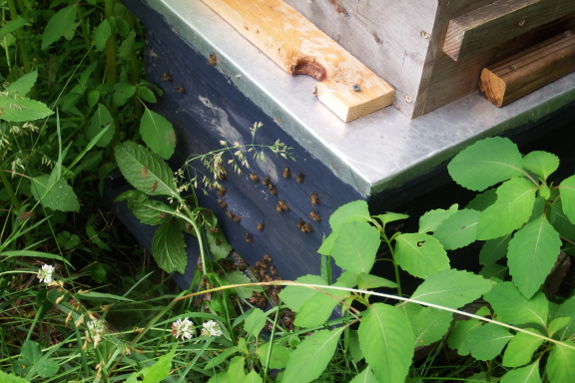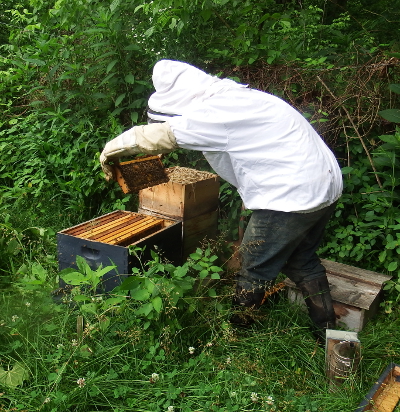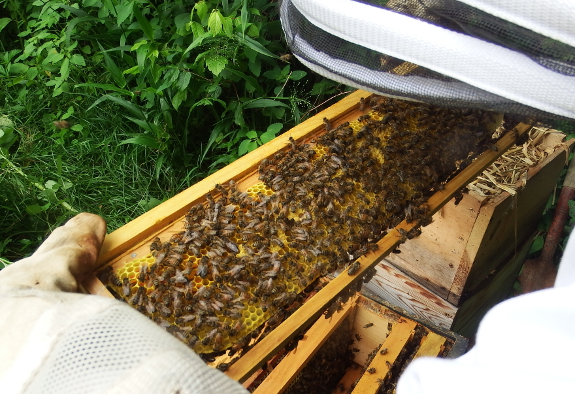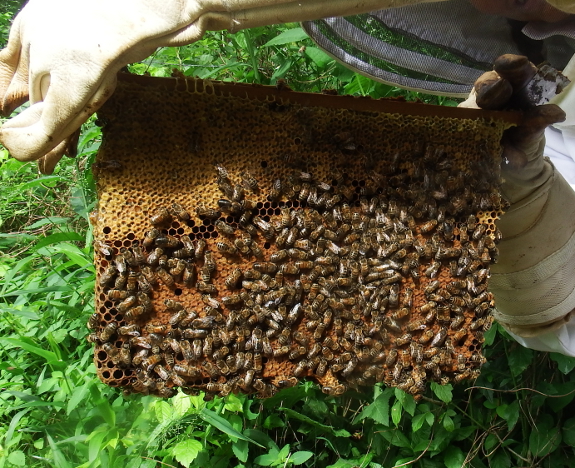
Splitting an incipient swarm

The swarm
lifted out of our hive at around 2 pm on Tuesday. It wasn't swarming
weather, though. By the time the cluster had formed around a branch high
in a box-elder tree, rain was coming down fast and it continued to rain
for the rest of the day.
I
sat on the back porch and watched the swarm for that entire time
period, but I still wasn't quite able to see what happened between
raindrops. However, I'm pretty sure I would have seen and heard if the
swarm flew away en masse --- noticing their roar from the back porch was
how I was alerted to the swarm in the first place, after all.
My best guess is that the swarm settled back down into the hive soon
after it started to rain. This suspicion arose when I went to check the
hive out around 4:30 pm and saw bees fanning a lemony odor into the
entrance, which is what swarms do to attract stragglers once they find a
new home. To confirm, I pushed my ear up against the boxes and heard a
roar just as loud (or louder) than usual. Yes, I was 80% sure the swarm
had gone back home.
Unfortunately, we didn't bait any swarm traps this year. So chances were pretty good that if the swarm left, it would disappear into the ether like our first one did. Not wanting to lose half of the hive's productivity for the year, I opted instead to beg them to stay.
 "Beg them to stay?" you say. "What in the world are you talking about?" Well, a hive split can sometimes prevent an incipient swarm,
especially if the queen ends up in one hive and the queen cells (which
will soon hatch into new queens) end up in the other. The best way to
ensure this happens is to go through frame by frame in search of both
the queen and the queen cells, but a Warre hive isn't set up for
fine-scale manipulation. So Mark and I instead opted to simply split the
hive as best we could and hope we'd get lucky.
"Beg them to stay?" you say. "What in the world are you talking about?" Well, a hive split can sometimes prevent an incipient swarm,
especially if the queen ends up in one hive and the queen cells (which
will soon hatch into new queens) end up in the other. The best way to
ensure this happens is to go through frame by frame in search of both
the queen and the queen cells, but a Warre hive isn't set up for
fine-scale manipulation. So Mark and I instead opted to simply split the
hive as best we could and hope we'd get lucky.

When I first saw this year's swarm, I suspected that our Warre-to-Langstroth converter
had been a failure. Why else would the bees swarm if they had two empty
boxes to build into? However, after removing the Warre half of the hive
and placing it on a piece of plywood to keep buzz-bys to a minimum, I
found that the top Langstroth box was entirely full of drawn comb neatly
packed with honey and pollen! In other words, the converter was a
resounding success.
Now that I do the math,
though, I realize that I probably waited until too late in the spring to
add more space. If there are queen cells about to hatch in the hive
right now, then their eggs would have been laid in the first week of
May...and we didn't put our converter in place until May 7. Next year,
we clearly need to add more space to our hive in April, especially if we
treat the bees to a bit of early spring feeding.

Unfortunately, there was
no brood in the Langstroth box. My hope had been that I could split the
hive at the converter, ending up with one Langstroth hive and one Warre
hive. But bees don't stay in a hive with no brood, so I had to instead
leave the converter in place and divvy up the two Warre boxes between
the two hives.
Best-case scenario, the queen will be in one hive and the queen cells in
the other, and both will be ready for business as usual shortly.
Worst-case scenario, hopefully there will at least be eggs in each hive
that will allow the workers to make a new queen if all of the current
monarchs end up stuffed together. In that worst-case scenario, we'd
probably still see a swarm within the next few days, so I'll likely know
one way or another pretty soon.
So now we have one
Warre/Langstroth hybrid and one Warre hive and are crossing our fingers
that they both take. Mark thinks he might be able to rig a way to set
Warre frames inside a Langstroth hive so we can convert the other hive
over to Langstroth with a shortcut method, and I'm looking forward to
the basswood flowers opening on our tree soon, so there's lots of buzz to come in the apiary. Stay tuned!
Want more in-depth information? Browse through our books.
Or explore more posts by date or by subject.
About us: Anna Hess and Mark Hamilton spent over a decade living self-sufficiently in the mountains of Virginia before moving north to start over from scratch in the foothills of Ohio. They've experimented with permaculture, no-till gardening, trailersteading, home-based microbusinesses and much more, writing about their adventures in both blogs and books.
Want to be notified when new comments are posted on this page? Click on the RSS button after you add a comment to subscribe to the comment feed, or simply check the box beside "email replies to me" while writing your comment.
